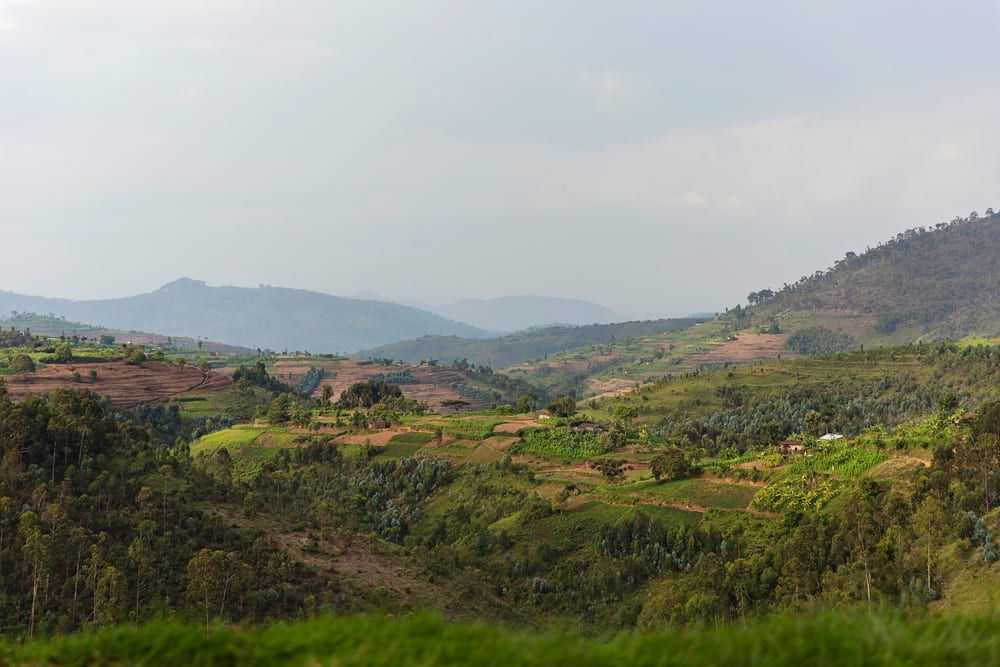Dec 1-2
As I type, we’re on the bus making the 3-hour journey to the border town of Gisenyi, in Rwanda’s northwest, which will be our last stop in Rwanda before crossing the border into Goma, DRC.
My morning highlight today was looking out my bus window and catching the eye of a young girl, perhaps 4 years old, decked out in what appeared to be her Sunday best (despite today being Wednesday). I think mine may have been the firsts white face she’s seen; the mix of wonder and elation on her face as she waved and looked up to her father to figure out what she should do next was just priceless.
We’ve been to Nyabugogo bus station twice and, while we’ve seen faces that were happy, curious, intent on doing business, or marked by scars from the war, Rich’s is still the only other white face I’ve seen there, which futher strengthens my opinion that this is not a country visited by many independent travellers. But let’s go back a couple of days…
On Monday, after a false start the day before, we rented a RAV4 so that we could drive to Nyungwe Forest National Park, a mountain rainforest in the southwest corner of the country, which is home to 13 species of primates and over 250 species of birds, not to mention various types of endemic flora (most notably impatiens and orchids). The plan was fairly straightforward: visit the Kigali Genocide Memorial, the Nyamagabe Genocide Memorial (see my next post for details of those visits), and then go to Nyungwe. With only two turns to make once we’d made it out of Kigali, it wasn’t a very overwhelming journey to plan. Turns out, though, that we’d planned a trip that would teach us some valuable lessons about Rwandan tourism.
The journey out of Kigali was uneventful, but spectacular, and it gave us a chance to really see just how gorgeous this country is. Before we’d reached the edge of the city, we passed a large field, overgrown with tall grass and home to a heavy machinery graveyard of sorts. Standing atop one rusted out piece of equipment, a young boy spread his arms while he looked down at his friend, half-hidden in the grass below. There were simple soccer fields – really just stretches of grass with a large goal at either end made from hewn trees, the field of play indicated by bare dirt on the most heavily-trodden paths; a group of young children formed a circle, happily hopping from foot to foot while the eldest of the bunch sang a song; a young boy spotted us as we rounded a long bend and smiled while hollering, “Mzunguuuuuuuuuu!” (“White persooooooooon!”); terraced farms, the lines of ridges separated by rich green valleys – it was breathtaking. Even now as I type, our bus is passing along a ridge from which, through the clouds of low-hanging mist and haze, I can see five other hilltops, each sloping down into neatly partitioned, perfectly green fields of corn, sweet potato, banana palms or rice; each demarcated by irrigation/flood trenches to help the farms withstand the runoff during the rainy season; each leading to small clusters of homes in the villages at the bottom and each dotted with the diamond-white pockmarks indicative of a farmer’s small home. It’s incredible.
We made it east as far as Gitarama, where turn 1 of 2 had to happen, and we stopped briefly for lunch. I ordered three goat brochettes, Rich ordered stuffed beef fillet (surprise surprise). Twenty minutes passed; a door at the other end of our courtyard restaurant opened, and a man walked through, leading “Brochette” on a rope to the kitchen. I’m not sqeamish about meat – I firmly believe that if you’re going to eat it, you’d better understand where it comes from and how it ends up on your plate, so I found this little scene pretty hilarious. Brochette provided the soundtrack for the rest of our meal (in competition with the Top 20 80s Love Songs videos that were playing on the TV, courtesy of MTV France – anyone who knows my musical preferences will understand how much I’d prefer to just listen to the goat), so it appeared that he was to be someone else’s lunch and not mine. Our meal arrived; my goat was a bit tough (as expected) but tasty and Rich’s beef was… a fish brochette. :) We aren’t quite sure how this interesting bit of language confusion happened, but it amused us for several hours.
After lunch, we drove south to Huye (HOO-yay; still one of my favourite city names to say – it’s impossible to sound anything but happy when you say it) and made turn 2 of 2 to head west towards Nyungwe.
Once again, Lonely Planet is proving to be a nearly pointless travel companion, leading us to feel like we are wandering aimlessly through this country, despite having a particular destination in mind each time. We never rely solely on LP for info, but we do use it as a starting point. Their incomplete maps and missing or outdated information have led us astray in the past, and this trip is no exception (note: we don’t hold them responsible for outdated info; that’s a side effect of using printed data – it’s not a living document). It’s not their fault that, in the years since their most recent East Africa guide was published, Kigali went ahead and renamed ALL of their streets, but names have been incomplete or inaccurate, maps have been incomplete or absent, and key info (like the location of a guesthouse they review) has been omitted. So we drove, in the gathering darkness, past our first stop in search of accommodation, without realising that we’d missed it because the description was incomplete. And again past our second because we didn’t have a map or a description of where to find it. In the end, desperation led us to follow a sign for the only guesthouse we’d seen that didn’t cost $250. We drove up a hill into a black abyss and ended up at a very expensive hilltop guesthouse that we had entirely to ourselves. Had I not been so extremely irritated by the turn of events we were currently caught in, I think I would’ve had a mini dance party in the middle of the courtyard because there was no one to disturb and we were, quite literally, on top of (that part of) the world. Supper was a fairly quiet affair while Rich graciously tolerated my despair over the cost of the room and how frustrated I was starting to feel. As usual, he was quick to see the humour in the situation, which was fortunate for us both.
Our hotel, while exceedingly overpriced, was a really neat spot. We had prime seats for the evening’s huge thunderstorm – it’s a wonder we didn’t get struck by the lightning that seemed to surround us – and awesome views at breakfast the following morning, when could see Lake Kivu off in the distance, past the dozen hills that came before it. By the time we left, a hazy mist was starting to roll in from the southeast and by the time we reached Nyungwe, it was clear that the weather that day would be anything but ideal.
We also learned a few other key details that we didn’t find in our research: 1) Uwinka Overlook is the name of the main visitors’ centre 2) Its campsite is under construction until March 2015, so we couldn’t have stayed there anyway 3) Gisakura Guest House is actually on the same property as the Gisakura park office 4) The Gisakura park office is only signposted on the road in one direction 5) You can’t book walks on the coloured trails from the Gisakura office 6) Hiking on the coloured trails only begins at 9am (making our 6am wake up completely pointless). See how the lack of info can get frustrating?
We had a 3.5 hour hike with a very pleasant guide (whose name, I’m embarassed to say, I didn’t catch clearly enough when he said it), who told us about his past jobs in the Virungas and Akagera (Rwanda’s safari park in the east of the country), his love of Nyungwe, and his family. He also told us a little about the current Chinese and Indian invasion taking place in the country – the construction workers employed to expand the mountainous road we traveled on through the park are being paid 7000 Rwandan Francs (about 1USD) per DAY. For perspective: the samosas that Rich bought at the start of this bus journey cost 200Rwf each; a simple loaf of brown bread costs 1000Rwf at the bakery. Most Rwandans eat one, or possibly two very simple meals per day.
The forest itself is beautiful. The hills that we see in the rest of the country are just as common in the park, meaning you cover all sorts of terrain, and see a variety of flora as a result. Mahogany and fig trees remain my firm favourites, but the prehistoric fern palms are always beautiful. We found a couple of ant colonies on the move, forming a band about an inch wide and dozens of feet long (for the part that was visible to us; they inevitably disappeared off into the undergrowth), as well as a few frogs and two 2.5 FOOT long earthworms.
While on our hike, the monkeys stayed hidden – we were told it was because of the inclement weather, but our long steady climb back up the stairs to the Visitors’ Centre was rewarded: half a dozen blue monkeys appeared out of the shrubbery and stuck around long enough for me to watch them eat various plants before they headed off down into the forest.
It was time to head back to Kigali, so after endless discussions about plans, we decided to leave our onward plans at the mercy of traffic and an unknown bus schedule. If we could get out of Kigali that night, we would go to the quiet, lakeside town of Kibuye, which is where we really wanted to go; if not, we would wait for the morning and make our way north to Gisenyi. A series of minor frustrations as a result of our Nyungwe errors means… we’re on our way to Gisenyi. :P
So, from our time in and out of (and back into) Kigali, we’ve learned that: 1) there don’t currently seem to be many people coming to Rwanda just for the sake of coming to Rwanda, unless they are already in East Africa; 2) those that do come don’t seem to travel by public transport; 3) bus companies are honest and consistent about pricing; taxi drivers very much less so; motorcycle taxis fall somewhere in the middle; 4) you can’t visit Rwanda on a shoestring budget AND you can’t do it in a rush.
Grateful for: Rich’s sense of humour when mine fails; hiking boots





